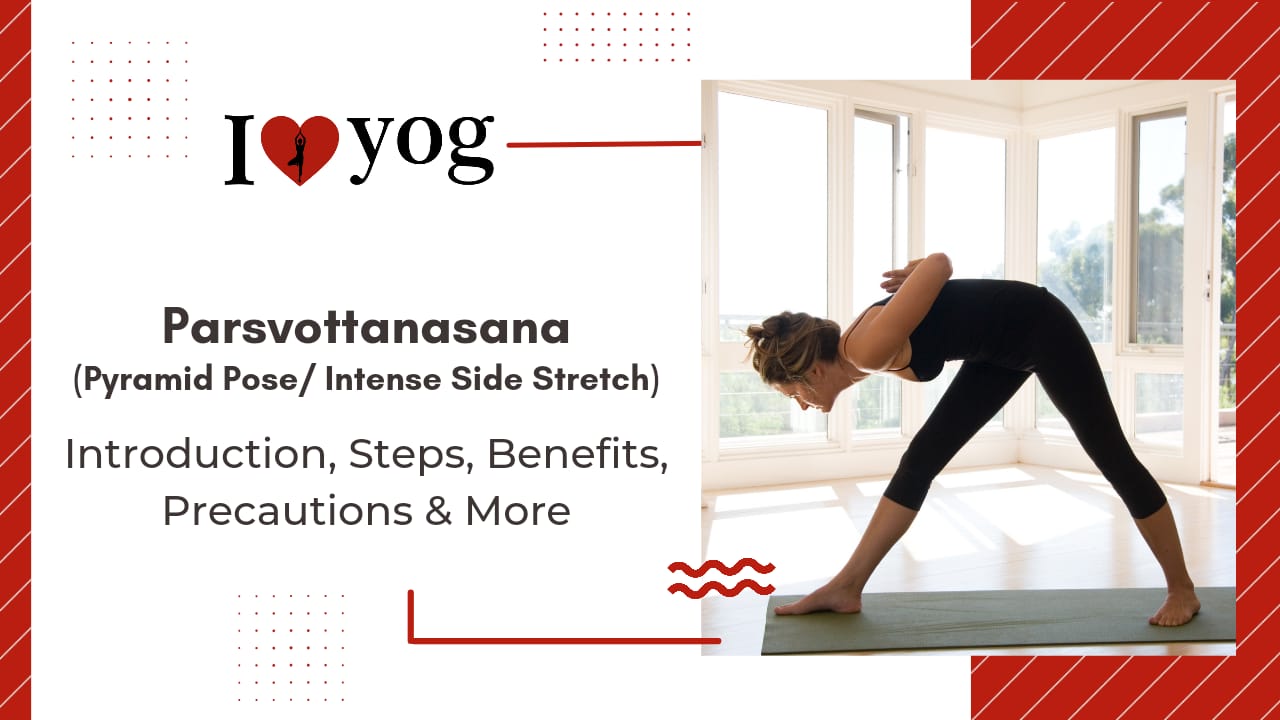What You Need to Know Before Attempting Pyramid Sana?
The pose should be performed on an empty stomach in the morning.
- Even if practised in the evening or at any other time of day, the stomach, bladder, and bowel should be empty.
- If it is practised at any other time of day outside the early morning, the practitioner should consume food 4 to 6 hours prior to practise. This will ensure that the stomach is empty by the time the individual assumes the posture, and the energy obtained from the food will aid in performing the pose with ease.
Preparative Poses
- Uttanasana (Standing Forward Bend)
- Adho Mukha Svanasana (Downward-Facing Dog)
- Prasarita Padottanasana (Wide-Legged Standing Forward Bend)
- Baddha Konasana (Bound Angle Pose)
- Gomukhasana (Cow Face Pose)
- Yogasana Level – Intermediate
- Yogasana Style – Standing, inversion, stretching
- Yogasana Repetitions – Both sides of the body after 30 seconds of holding
- Yogasana fortifies –
- Yogasana Flexions –
Pyramid Asana’s effect on tri dosha
It balances vata, pitta, and kapha dosha.
How To Do Pyramid yoga Posture/Asana?
- Begin standing in Tadasana (Mountain Pose) with your hands on your hips at the front of your mat. Move your left foot three-and-a-half to four feet backwards. Spin your left heel in and down to the mat so that your left foot points forward at an outward angle.
- With both feet flat on the mat, hug your legs together as if you were compressing a block between your inner thighs, then inhale and consciously stretch your spine. Exhale and hinge at the hips to stretch the torso over the front leg.
- Stop when your torso is parallel to the floor or when your lower back begins to curve. You can check this by placing your fingers on your lumbar spine. If the vertebrae are protruding, the lower back is rounded. Raise your torso until the lumbar spine begins to drop into your back.
- Firmly press both feet onto the mat while bringing the right hip back to stretch the right leg. Avoid allowing your right hip to swing out to the right.
- While maintaining an extended spine, release both hands to the floor (or blocks) on either side of your right foot. If you are unable to reach the blocks in this area, you can position yourself in front of a wall and press your hands into the wall to stretch your torso. As you stretch the front of your torso and move your heart forward, press all ten fingertips down and both thighbones back.
- Pause and take a breath here. If you have the flexibility, you can fold more deeply over the front leg, but maintain a long spine (and side bodies). Hold for five breath cycles.
- To release, firmly press both feet into the mat, bend your front knee slightly, and bring your hands to your hips. Inhale and stand with a flat back after exhaling. Repeat with your right foot forward and left foot back on the second side.
What Are the Benefits of the Pyramid Yoga Asana?
- In Pyramid Pose, the spine, shoulders, wrists, hips, and hamstrings are stretched.
- Additionally, it strengthens the legs and enhances posture.
- Relaxes the body and provides mental tranquilly.
- Improves the function of abdominal organs and is advantageous for the digestive system.
What Are the Contraindications and Cautions Regarding Pyramid Pose/Asana?
- If you have a back or shoulder issue, grip each elbow with the opposite hand rather than adopting the reverse prayer position. Alternately, you may rest your hands on your hips.
- Avoid locking the knee joints. If the hamstrings feel overworked, bend the knees only little.
- Pregnant ladies should avoid performing this pose.
- As this is a balancing asana, you should not close your eyes in the final posture.
What Is the Science Behind Pyramid Pose/Asana?
Pyramid Pose (Parsvottanasana) is a deep forward bend that serves to lengthen the spine and stretch the hip flexors and hamstrings. The pose’s limited parameters—a narrow stance, like to standing on railway tracks—require you to consciously create stability, strength, and integrity.
Tips For Beginners Regarding Pyramid Pose/Asana?
It is easy to take a too-wide stance when first attempting this pose. Move your feet closer together than they would be in a standing Crescent Lunge position so you can comfortably hinge forward from the hips while maintaining balance. Your vitality derives from your base. Apply pressure to each of the four corners of your feet to establish stability and integrity for the remainder of the pose.
Advanced Changes in Pose
- If you cannot easily reach the floor without arching your back, instead of compromising the integrity of the pose, place blocks or other support under your hands.
- To enhance the difficulty, extend your arms alongside your ears. Attempt the pose with your back heel elevated.
- As you inhale, perform additional work for the back muscles by lifting the arms out to the sides with bent elbows and pressing the shoulder blades together.
- Lower the arms while exhaling. Repeat between three and four times.
Corresponding Yoga Poses/Asanas –
Counter poses
- Dandasana (Staff Pose)
- Paschimottanasana (Seated Forward Bend)
- Uttanasana (Standing Forward Bend)
Reference:-
https://www.yogajournal.com/poses/intense-side-stretch-pose/


